formerly eScholarship Editions


|
|
|
|
Your request for similar items found 20 book(s). | Modify Search | Displaying 1 - 20 of 20 book(s) | |
| 1. | 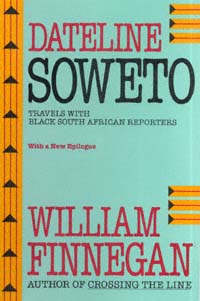 | Title: Dateline Soweto: travels with black South African reporters Author: Finnegan, William Published: University of California Press, 1995 Subjects: Media Studies | African Studies | Social Problems | Politics | African History Publisher's Description: Dateline Soweto documents the working lives of black South African reporters caught between the mistrust of militant blacks, police harrassment, and white editors who - fearing government disapproval - may not print the stories these reporters risk their lives to get. William Finnegan revisited seve . . . [more] Similar Items |
| 2. | 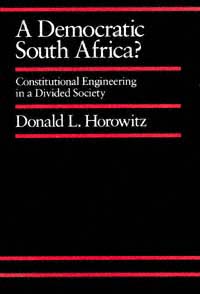 | Title: A democratic South Africa?: constitutional engineering in a divided society Author: Horowitz, Donald L Published: University of California Press, 1991 Subjects: Politics | African Studies | Sociology | Law Publisher's Description: Can a society as deeply divided as South Africa become democratic? In a most timely work, Donald L. Horowitz, author of the acclaimed Ethnic Groups in Conflict , points to the conditions that make democracy an improbable outcome in South Africa. At the same time, he identifies ways to overcome these obstacles, and he describes institutions that offer constitution makers the best chance for a democratic future.South Africa is generally considered an isolated case, a country unlike any other. Drawing on his extensive experience of racially and ethnically divided societies, however, Horowitz brings South Africa back into African and comparative politics. Experience gained in Nigeria, Botswana, Zimbabwe, and other divided societies around the world is relevant because, as South Africa leaves apartheid behind, it will still confront problems of pluralism: racial, ethnic, and ideological. Countries like South Africa, Horowitz argues, must develop institutions capable of coping with such divisions.Reviewing an array of constitutional proposals for South Africa - group rights, consociation, partition, binationalism, and an enhanced role for the judiciary - Horowitz shows that most are inappropriate for the country's problems, or else run afoul of some major ideological taboo. Institutions that are both apt and acceptable do exist, however. These are premised on the need to create incentives for accommodation across group lines. In the final chapter, Horowitz makes a major contribution to the theory of democratization as he considers how commitments to democracy might be extracted even from political groups with undemocratic objectives.Ranging skillfully across studies of social distance and stereotypes, electoral and party systems, constitutions and judiciaries, conflict and accommodation, and negotiation and democratization, Horowitz displays a broad comparative vision. His innovative study will change the way theorists and practitioners approach the task of making democracy work in difficult conditions. [brief] Similar Items |
| 3. | 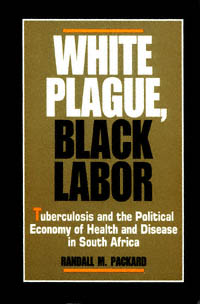 | Title: White plague, black labor: tuberculosis and the political economy of health and disease in South Africa Author: Packard, Randall M 1945- Published: University of California Press, 1989 Subjects: Anthropology | Medicine | Medical Anthropology | African Studies | Politics Publisher's Description: Why does tuberculosis, a disease which is both curable and preventable, continue to produce over 50,000 new cases a year in South Africa, primarily among blacks? In answering this question Randall Packard traces the history of one of the most devastating diseases in twentieth-century Africa, against the background of the changing political and economic forces that have shaped South African society from the end of the nineteenth century to the present. These forces have generated a growing backlog of disease among black workers and their families and at the same time have prevented the development of effective public health measures for controlling it. Packard's rich and nuanced analysis is a significant contribution to the growing body of literature on South Africa's social history as well as to the history of medicine and the political economy of health. [brief] Similar Items |
| 4. | 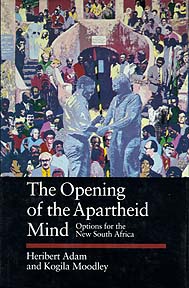 | Title: The opening of the Apartheid mind: options for the new South Africa Author: Adam, Heribert Published: University of California Press, 1993 Subjects: African Studies | Politics | African History Publisher's Description: Refusing to be governed by what is fashionable or inoffensive, Heribert Adam and Kogila Moodley frankly address the passions and rationalities that drive politics in post-apartheid South Africa. They argue that the country's quest for democracy is widely misunderstood and that public opinion abroad relies on stereotypes of violent tribalism and false colonial analogies.Adam and Moodley criticize the personality cult surrounding Nelson Mandela and the accolades accorded F. W. de Klerk. They reject the black-versus-white conflict and substitute sober analysis and strategic pragmatism for the moral outrage that typifies so much writing about South Africa. Believing that the best expression of solidarity emanates from sympathetic but candid criticism, they pose challenging questions for the African National Congress and Nelson Mandela. They give in-depth coverage to political violence, the ANC-South African Communist Party alliance, Inkatha, and other controversial topics as well.The authors do not propose a solution that will guarantee a genuinely democratic South Africa. What they offer is an understanding of the country's social conditions and political constraints, and they sketch options for both a new South Africa and a new post-Cold War foreign policy for the whole of southern Africa. The importance of this book is as immediate as today's headlines. [brief] Similar Items |
| 5. | 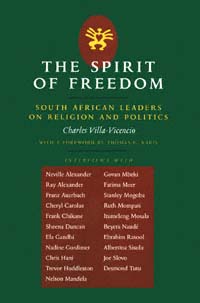 | Title: The spirit of freedom: South African leaders on religion and politics Author: Villa-Vicencio, Charles Published: University of California Press, 1996 Subjects: Religion | Politics | African Studies Publisher's Description: This collection of interviews explores the role of religion in the lives of eminent South Africans who led the struggle against apartheid. Nelson Mandela, Chris Hani, Desmond Tutu, Nadine Gordimer, and seventeen other political, religious, and cultural leaders share the beliefs and values that informed the moral positions they adopted, often at great cost. From all ethnic, religious, and political backgrounds, these men and women have shaped one of the greatest political transformations of the century.What emerges from the interviews are reflections on all aspects of life in an embattled country. There are stories of the homelands and townships, and tales of imprisonment and exile. Dedicated communists relate their intense youthful devotion to Christianity; Muslim activists discuss the complexity of their relationships with their communities. As the respondents grapple with difficult questions about faith, politics, and authority, they expose a more personal picture: of their daily lives, of their pasts, and of the enormous conflicts that arise in a society that continually strains the moral fiber of its citizens. Taken together, these interviews reveal the many-faceted vision that has fueled South Africa's struggle for democracy. [brief] Similar Items |
| 6. | 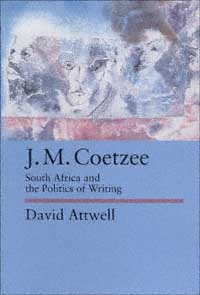 | Title: J.M. Coetzee: South Africa and the politics of writing Author: Attwell, David Published: University of California Press, 1993 Subjects: Literature | African Studies | Literary Theory and Criticism Publisher's Description: David Attwell defends the literary and political integrity of South African novelist J.M. Coetzee by arguing that Coetzee has absorbed the textual turn of postmodern culture while still addressing the ethical tensions of the South African crisis. As a form of "situational metafiction," Coetzee's writing reconstructs and critiques some of the key discourses in the history of colonialism and apartheid from the eighteenth century to the present. While self-conscious about fiction-making, it takes seriously the condition of the society in which it is produced.Attwell begins by describing the intellectual and political contexts surrounding Coetzee's fiction and then provides a developmental analysis of his six novels, drawing on Coetzee's other writings in stylistics, literary criticism, translation, political journalism and popular culture. Elegantly written, Attwell's analysis deals with both Coetzee's subversion of the dominant culture around him and his ability to see the complexities of giving voice to the anguish of South Africa. [brief] Similar Items |
| 7. | 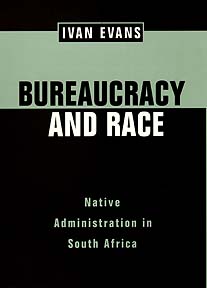 | Title: Bureaucracy and race: native administration in South Africa Author: Evans, Ivan Thomas 1957- Published: University of California Press, 1997 Subjects: African Studies | African History | Sociology | Postcolonial Studies | Cultural Anthropology Publisher's Description: Bureaucracy and Race overturns the common assumption that apartheid in South Africa was enforced only through terror and coercion. Without understating the role of violent intervention, Ivan Evans shows that apartheid was sustained by a great and ever-swelling bureaucracy. The Department of Native Affairs (DNA), which had dwindled during the last years of the segregation regime, unexpectedly revived and became the arrogant, authoritarian fortress of apartheid after 1948. The DNA was a major player in the prolonged exclusion of Africans from citizenship and the establishment of a racially repressive labor market. Exploring the connections between racial domination and bureaucratic growth in South Africa, Evans points out that the DNA's transformation of oppression into "civil administration" institutionalized and, for whites, legitimized a vast, coercive bureaucratic culture, which ensnared millions of Africans in its workings and corrupted the entire state. Evans focuses on certain features of apartheid - the pass system, the "racialization of space" in urban areas, and the cooptation of African chiefs in the Bantustans - in order to make it clear that the state's relentless administration, not its overtly repressive institutions, was the most distinctive feature of South Africa in the 1950s. All observers of South Africa past and present and of totalitarian states in general will follow with interest the story of how the Department of Native Affairs was crucial in transforming "the idea of apartheid" into a persuasive - and all too durable - practice. [brief] Similar Items |
| 8. | 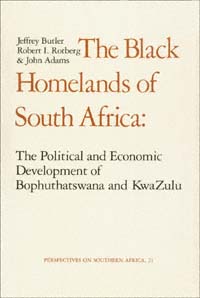 | Title: The black homelands of South Africa: the political and economic development of Bophuthatswana and KwaZulu Author: Butler, Jeffrey Published: University of California Press, 1978 Subjects: African Studies | African History | Politics Similar Items |
| 9. | 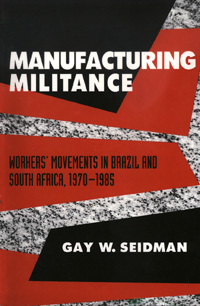 | Title: Manufacturing militance: workers' movements in Brazil and South Africa, 1970-1985 Author: Seidman, G Published: University of California Press, 1994 Subjects: Politics | Latin American Studies | African Studies | Labor Studies | Economics and Business Publisher's Description: Challenging prevailing theories of development and labor, Gay Seidman's controversial study explores how highly politicized labor movements could arise simultaneously in Brazil and South Africa, two starkly different societies. Beginning with the 1960s, Seidman shows how both authoritarian states promoted specific rapid-industrialization strategies, in the process reshaping the working class and altering relationships between business and the state. When economic growth slowed in the 1970s, workers in these countries challenged social and political repression; by the mid-1980s, they had become major voices in the transition from authoritarian rule.Based in factories and working-class communities, these movements enjoyed broad support as they fought for improved social services, land reform, expanding electoral participation, and racial integration.In Brazil, Seidman takes us from the shopfloor, where disenfranchized workers organized for better wages and working conditions, to the strikes and protests that spread to local communities. Similar demands for radical change emerged in South Africa, where community groups in black townships joined organized labor in a challenge to minority rule that linked class consciousness to racial oppression. Seidman details the complex dynamics of these militant movements and develops a broad analysis of how newly industrializing countries shape the opportunities for labor to express demands. Her work will be welcomed by those interested in labor studies, social theory, and the politics of newly industrializing regions. [brief] Similar Items |
| 10. | 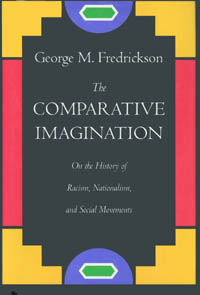 | Title: The comparative imagination: on the history of racism, nationalism, and social movements Author: Fredrickson, George M 1934- Published: University of California Press, 1997 Subjects: History | United States History Publisher's Description: In this collection of essays, an eminent American historian of race relations discusses issues central to our understanding of the history of racism, the role of racism, and the possibilites for justice in contemporary society. George M. Fredrickson provides an eloquent and vigorous examination of race relations in the United States and South Africa and at the same time illuminates the emerging field of comparative history - history that is explicitly cross-cultural in its comparisons of nations, eras, or social structures. Taken together, these thought-provoking, accessible essays - several never before published - bring new precision and depth to our understanding of racism and justice, both historically and for society today.The first group of essays in The Comparative Imagination summarizes and evaluates the cross-national comparative history written in the past fifty years. These essays pay particular attention to comparative work on slavery and race relations, frontiers, nation-building and the growth of modern welfare states, and class and gender relations. The second group of essays represents some of Fredrickson's own explorations into the cross-cultural study of race and racism. Included are new essays covering such topics as the theoretical and cross-cultural meaning of racism, the problem of race in liberal thought, and the complex relationship between racism and state-based nationalism. The third group contains Fredrickson's recent work on anti-racist and black liberation movements in the United States and South Africa, especially in the period since World War II.In addition, Fredrickson's provocative introduction breaks significant new intellectual ground, outlining a justification for the methods of comparative history in light of such contemporary intellectual trends as the revival of narrative history and the predominance of postmodern thought. [brief] Similar Items |
| 11. | 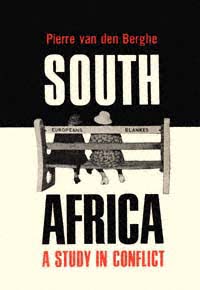 | Title: South Africa, a study in conflict Author: Van den Berghe, Pierre L Published: University of California Press, 1967 Subjects: African Studies Similar Items |
| 12. | 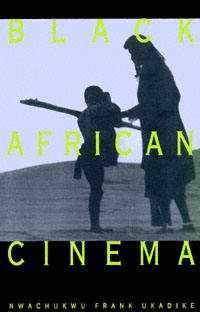 | Title: Black African cinema Author: Ukadike, Nwachukwu Frank Published: University of California Press, 1994 Subjects: Cinema and Performance Arts | Film Publisher's Description: From the proselytizing lantern slides of early Christian missionaries to contemporary films that look at Africa through an African lens, N. Frank Ukadike explores the development of black African cinema. He examines the impact of culture and history, and of technology and co-production, on filmmaking throughout Africa.Every aspect of African contact with and contribution to cinematic practices receives attention: British colonial cinema; the thematic and stylistic diversity of the pioneering "francophone" films; the effects of television on the motion picture industry; and patterns of television documentary filmmaking in "anglophone" regions. Ukadike gives special attention to the growth of independent production in Ghana and Nigeria, the unique Yoruba theater-film tradition, and the militant liberationist tendencies of "lusophone" filmmakers. He offers a lucid discussion of oral tradition as a creative matrix and the relationship between cinema and other forms of popular culture. And, by contrasting "new" African films with those based on the traditional paradigm, he explores the trends emerging from the eighties and nineties.Clearly written and accessible to specialist and general reader alike, Black African Cinema 's analysis of key films and issues - the most comprehensive in English - is unique. The book's pan-Africanist vision heralds important new strategies for appraising a cinema that increasingly attracts the attention of film students and Africanists. [brief] Similar Items |
| 13. |  | Title: Justice in South Africa, Author: Sachs, Albie 1935- Published: University of California Press, 1973 Subjects: African Studies | Politics | Law Similar Items |
| 14. | 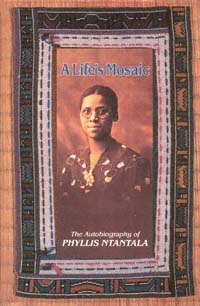 | Title: A life's mosaic: the autobiography of Phyllis Ntantala Author: Ntantala, Phyllis Published: University of California Press, 1993 Subjects: Literature | African Studies | Autobiography | African American Studies Publisher's Description: "Like Trotsky, I did not leave home with the proverbial one-and-six in my pocket. I come from a family of landed gentry . . . [and] could have chosen the path of comfort and safety, for even in apartheid South Africa, there is still that path for those who will collaborate. But I chose the path of struggle and uncertainty." - from the Preface Born into the small social elite of black South Africa, Phyllis Ntantala did not face the grinding poverty so familiar to other South African blacks. Instead, her struggle was that of a creative, articulate woman seeking fulfillment and justice in a land that tried to deny her both.The widow of Xhosa writer and historian A.C. Jordan and mother of African National Congress leader Z. Pallo Jordan, she and her family experienced a period of tremendous change in South Africa and also in the United States, where they moved during the 1960s. She discovers similarities in the two countries, including the arrogance of power.Anchored in history and culture, A Life's Mosaic sharply reveals the world and the people of South Africa. As the story of a political exile, it represents the dislocations that have caused universal suffering in the second half of the twentieth century. Phyllis Ntantala discusses the cruelty of racism, the cynicism of political solutions, and the hopes of those who live in both a world of exile and a world of dreams. [brief] Similar Items |
| 15. | 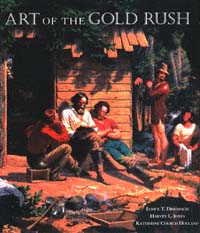 | Title: Art of the gold rush Author: Driesbach, Janice Tolhurst Published: University of California Press, 1998 Subjects: Art | California and the West | Californian and Western History Publisher's Description: The California Gold Rush captured the get-rich dreams of people around the world more completely than almost any event in American history. This catalog, published in celebration of the sesquicentennial of the 1848 discovery of gold at Sutter's Mill, shows the vitality of the arts in the Golden State during the latter nineteenth century and documents the dramatic impact of the Gold Rush on the American imagination.Among the throngs of gold-seekers in California were artists, many self-taught, others formally trained, and their arrival produced an outpouring of artistic works that provide insights into Gold Rush events, personages, and attitudes. The best-known painting of the Gold Rush era, C.C. Nahl's Sunday Morning in the Mines (1872), was created nearly two decades after gold fever had subsided. By then the Gold Rush's mythic qualities were well established, and new allegories - particularly the American belief in the rewards of hard work and enterprise - can be seen on Nahl's canvas. Other works added to the image of California as a destination for ambitious dreamers, an image that prevails to this day. In bringing together a range of art and archival material such as artists' diaries and contemporary newspaper articles, The Art of the Gold Rush broadens our understanding of American culture during a memorable period in the nation's history. [brief] Similar Items |
| 16. | 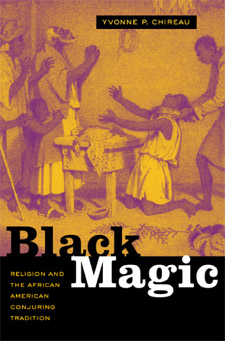 | Title: Black magic: religion and the African American conjuring tradition Author: Chireau, Yvonne Patricia 1961- Published: University of California Press, 2003 Subjects: Religion | African Studies | American Studies | United States History | African American Studies Publisher's Description: Black Magic looks at the origins, meaning, and uses of Conjure - the African American tradition of healing and harming that evolved from African, European, and American elements - from the slavery period to well into the twentieth century. Illuminating a world that is dimly understood by both scholars and the general public, Yvonne P. Chireau describes Conjure and other related traditions, such as Hoodoo and Rootworking, in a beautifully written, richly detailed history that presents the voices and experiences of African Americans and shows how magic has informed their culture. Focusing on the relationship between Conjure and Christianity, Chireau shows how these seemingly contradictory traditions have worked together in a complex and complementary fashion to provide spiritual empowerment for African Americans, both slave and free, living in white America. As she explores the role of Conjure for African Americans and looks at the transformations of Conjure over time, Chireau also rewrites the dichotomy between magic and religion. With its groundbreaking analysis of an often misunderstood tradition, this book adds an important perspective to our understanding of the myriad dimensions of human spirituality. [brief] Similar Items |
| 17. | 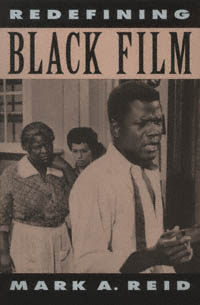 | Title: Redefining Black film Author: Reid, Mark (Mark A.) Published: University of California Press, 1993 Subjects: Cinema and Performance Arts | Film | African American Studies Publisher's Description: Can films about black characters, produced by white filmmakers, be considered "black films"? In answering this question, Mark Reid reassesses black film history, carefully distinguishing between films controlled by blacks and films that utilize black talent, but are controlled by whites. Previous black film criticism has "buried" the true black film industry, Reid says, by concentrating on films that are about, but not by, blacks.Reid's discussion of black independent films - defined as films that focus on the black community and that are written, directed, produced, and distributed by blacks - ranges from the earliest black involvement at the turn of the century up through the civil rights movement of the Sixties and the recent resurgence of feminism in black cultural production. His critical assessment of work by some black filmmakers such as Spike Lee notes how these films avoid dramatizations of sexism, homophobia, and classism within the black community.In the area of black commercial film controlled by whites, Reid considers three genres: African-American comedy, black family film, and black action film. He points out that even when these films use black writers and directors, a black perspective rarely surfaces.Reid's innovative critical approach, which transcends the "black-image" language of earlier studies - and at the same time redefines black film - makes an important contribution to film history. Certain to attract film scholars, this work will also appeal to anyone interested in African-American and Women's Studies. [brief] Similar Items |
| 18. | 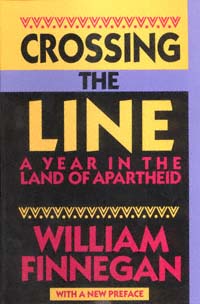 | Title: Crossing the line: a year in the land of apartheid Author: Finnegan, William Published: University of California Press, 1994 Subjects: African Studies | Politics | Social Problems | Autobiography | Education | African History Publisher's Description: William Finnegan's compelling account of a year spent teaching in a colored high school, "across the line," in Cape Town, South Africa brings the irrationality and injustice of apartheid into focus for the American reader. A new preface, written after the author's observation of the historic 1994 el . . . [more] Similar Items |
| 19. | 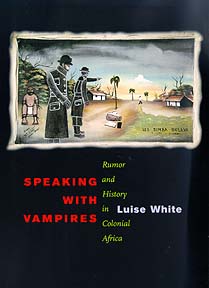 | Title: Speaking with vampires: rumor and history in colonial Africa Author: White, Luise Published: University of California Press, 2000 Subjects: African Studies | African History | African Studies | Cultural Anthropology Publisher's Description: During the colonial period, Africans told each other terrifying rumors that Africans who worked for white colonists captured unwary residents and took their blood. In colonial Tanganyika, for example, Africans were said to be captured by these agents of colonialism and hung upside down, their throats cut so their blood drained into huge buckets. In Kampala, the police were said to abduct Africans and keep them in pits, where their blood was sucked. Luise White presents and interprets vampire stories from East and Central Africa as a way of understanding the world as the storytellers did. Using gossip and rumor as historical sources in their own right, she assesses the place of such evidence, oral and written, in historical reconstruction. White conducted more than 130 interviews for this book and did research in Kenya, Uganda, and Zambia. In addition to presenting powerful, vivid stories that Africans told to describe colonial power, the book presents an original epistemological inquiry into the nature of historical truth and memory, and into their relationship to the writing of history. [brief] Similar Items |
| 20. | 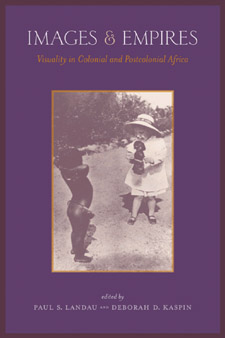 | Title: Images and empires: visuality in colonial and postcolonial Africa Author: Landau, Paul Stuart 1962- Published: University of California Press, 2002 Subjects: Anthropology | African Studies | Art History | Cultural Anthropology | History Publisher's Description: Figurative images have long played a critical, if largely unexamined, role in Africa - mediating relationships between the colonizer and the colonized, the state and the individual, and the global and the local. This pivotal volume considers the meaning and power of images in African history and culture. Paul S. Landau and Deborah Kaspin have assembled a wide-ranging collection of essays dealing with specific visual forms, including monuments, cinema, cartoons, domestic and professional photography, body art, world fairs, and museum exhibits. The contributors, experts in a number of disciplines, discuss various modes of visuality in Africa and of Africa, investigating the interplay of visual images with personal identity, class, gender, politics, and wealth. Integral to the argument of the book are over seventy contextualized illustrations. Africans saw foreigners in margarine wrappers, Tintin cartoons, circus posters, and Hollywood movies; westerners gleaned impressions of Africans from colonial exhibitions, Tarzan films, and naturalist magazines. The authors provide concrete examples of the construction of Africa's image in the modern world. They reveal how imperial iconographies sought to understand, deny, control, or transform authority, as well as the astonishing complexity and hybridity of visual communication within Africa itself. [brief] Similar Items |